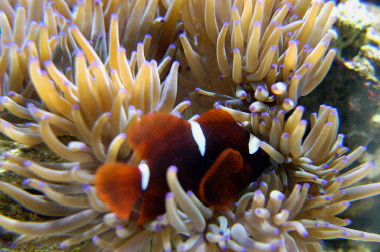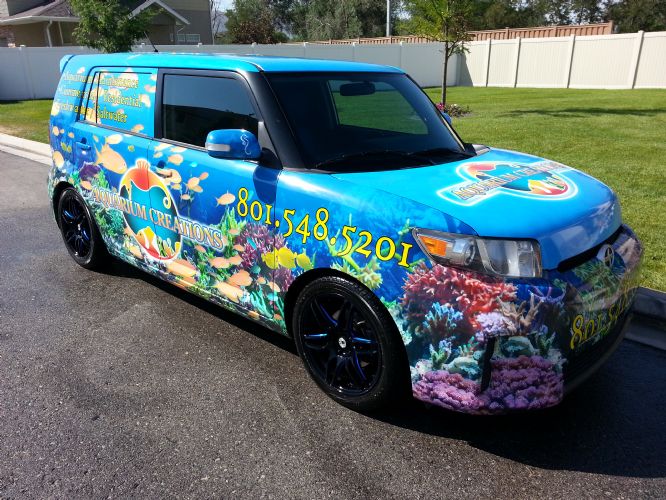| Author |
 Topic Search Topic Search  Topic Options Topic Options
|
MBX5 
Guest


Joined: December 23 2004
Location: United States
Status: Offline
Points: 315
|
 Post Options Post Options
 Thanks(0) Thanks(0)
 Quote Quote  Reply Reply
 Topic: Anemone color change help? Topic: Anemone color change help?
Posted: March 30 2005 at 4:15pm |
This anemone started off white like the first pic but now it has become
greenish brown? Any clue why or if it means something is wrong? It has
been brown for like the last 2 months and still seems fine. Thanks for
any help. Sorry for the bad pics.


|

Joe Barnas
Westminster, CO
|
 |
Aquarium Creations 
Pet Store


Joined: August 20 2003
Location: DRAPER
Status: Offline
Points: 3234
|
 Post Options Post Options
 Thanks(0) Thanks(0)
 Quote Quote  Reply Reply
 Posted: March 30 2005 at 4:18pm Posted: March 30 2005 at 4:18pm |
|
Thats a great sign most will never go back to that color i have one aswell
|
Aquarium Maintenance,Consulting,Custom Built Glass Aquariums Rimless/Euro,24Hr Emergency Service 8015485201 Www.UtahAquariumDoctors.com [email protected]
|
 |
MBX5 
Guest


Joined: December 23 2004
Location: United States
Status: Offline
Points: 315
|
 Post Options Post Options
 Thanks(0) Thanks(0)
 Quote Quote  Reply Reply
 Posted: March 30 2005 at 4:19pm Posted: March 30 2005 at 4:19pm |
|
So it should be the green/brown?
Oh and do you work today?
Edited by MBX5
|

Joe Barnas
Westminster, CO
|
 |
dmanshep 
Guest


Joined: October 11 2002
Location: United States
Status: Offline
Points: 703
|
 Post Options Post Options
 Thanks(0) Thanks(0)
 Quote Quote  Reply Reply
 Posted: March 30 2005 at 4:26pm Posted: March 30 2005 at 4:26pm |
|
yeah thats awesome , it's a sign that it has regained it's zooxanthellae, the symbiotic algae that is needed for it's continued health. When they are pure white this is a sign that this zooxanthellae has left the animal.
zo·o·xan·thel·la
Any of various yellow-green algae that live symbiotically within the cells of other organisms, such as those of certain radiolarians and marine invertebrates.
Edited by dmanshep
|
 |
MBX5 
Guest


Joined: December 23 2004
Location: United States
Status: Offline
Points: 315
|
 Post Options Post Options
 Thanks(0) Thanks(0)
 Quote Quote  Reply Reply
 Posted: March 30 2005 at 4:32pm Posted: March 30 2005 at 4:32pm |
|
cool thanks!
|

Joe Barnas
Westminster, CO
|
 |
WhiteReef 
Paid Member


Joined: September 03 2002
Location: Magna, UT
Status: Offline
Points: 1014
|
 Post Options Post Options
 Thanks(0) Thanks(0)
 Quote Quote  Reply Reply
 Posted: March 30 2005 at 5:29pm Posted: March 30 2005 at 5:29pm |
|
Joe- I had the same thing happen with my anemone. As was stated, it is a good sign of the anemones health. The thing that shocked me is the change process. Mine looked as if it had algae growing on the outside of it. As time progressed it was more and more evident that it was the zooanthella algae growing.
|
|
----------------
Richard
Former 47G Column Reef, Magna
20" x 18" x 31"H
|
 |
Ghetto Man 
Guest


Joined: February 12 2004
Location: Sandy
Status: Offline
Points: 441
|
 Post Options Post Options
 Thanks(0) Thanks(0)
 Quote Quote  Reply Reply
 Posted: March 30 2005 at 11:21pm Posted: March 30 2005 at 11:21pm |
|
That's funny - I was just wondering the same thing about mine. I was assuming it was sick. Show's what I know.
|
 |
Jared Wood 
Guest


Joined: January 27 2004
Location: United States
Status: Offline
Points: 490
|
 Post Options Post Options
 Thanks(0) Thanks(0)
 Quote Quote  Reply Reply
 Posted: March 31 2005 at 10:39am Posted: March 31 2005 at 10:39am |
It is time to start pretending that it is an maroon anemone 
|
In the beginning, God created the heaven and the earth ... then He let it cycle. Have you read my dinosaur theory yet?
|
 |
Carl 
Guest


Joined: September 17 2003
Location: United States
Status: Offline
Points: 1346
|
 Post Options Post Options
 Thanks(0) Thanks(0)
 Quote Quote  Reply Reply
 Posted: March 31 2005 at 11:32am Posted: March 31 2005 at 11:32am |
"When they are pure white this is a sign that this zooxanthellae has left the animal."
Generally I would agree, but in these anemones I do not believe that this is true. A change in color IS associated with a change in the zooxanthellae, but the zooxanthellae can also take on different colors depending upon other conditions around it such as light, temperature, etc.
As an example...
Heteractis crispa or H. malu, Sebae anemone, Singapore anemone, pink-tipped (but not condylactis) anemone
Tentacles range from long and thin to short and fat depending on the condition of the anemone (short and fat usually means it is starting to waste away). Tentacles usually have magenta colored tips although yellowish-green tips are not uncommon. Colors can be dyed yellow, dyed pink, natural pink/purple, natural yellow, tan, but by far the most common is pure white. The oral disk may also have a green sheen under actinic light.
|
|
In Syracuse
"I believe that forgiving them is God's function. Our job is simply to arrange the meeting." - Gen. H. Norman Schwarzkopf
|
 |
Jake Pehrson 
Admin Group


Joined: June 13 2002
Location: Murray, UT
Status: Offline
Points: 4279
|
 Post Options Post Options
 Thanks(0) Thanks(0)
 Quote Quote  Reply Reply
 Posted: March 31 2005 at 11:39am Posted: March 31 2005 at 11:39am |
Carl,
Where is that quote from?
I have never seen a Sebae live for longer then a year in captivity without regaining (at least in my opinion) it's zooxanthellae and turning at least slightly brown.
Also I would like to know the reference to where zooxanthellae can change color in different conditions.
|
|
|
 |
dmanshep 
Guest


Joined: October 11 2002
Location: United States
Status: Offline
Points: 703
|
 Post Options Post Options
 Thanks(0) Thanks(0)
 Quote Quote  Reply Reply
 Posted: March 31 2005 at 11:39am Posted: March 31 2005 at 11:39am |
interesting , I would say there is a lot of merrit in the fact that zooxanthellae can change color. Hence looks at all this sps that looks one way in someones tank and then takes on a whole new look in another. I also feel that there is alot to be said about what someone might feed,
a good read about zooxanthellae if you have time
http://www.advancedaquarist.com/issues/feb2002/cw.htm
|
 |
Carl 
Guest


Joined: September 17 2003
Location: United States
Status: Offline
Points: 1346
|
 Post Options Post Options
 Thanks(0) Thanks(0)
 Quote Quote  Reply Reply
 Posted: March 31 2005 at 11:56am Posted: March 31 2005 at 11:56am |
 Jake Pehrson wrote: Jake Pehrson wrote:
Where is that quote from?
Also I would like to know the reference to where zooxanthellae can change color in different conditions.
|
Jake, take a look at http://fins.actwin.com/species/anemone.html as one example.
I will also agree with you that it is often impossible or at least unlikely that they will survive in captivity. Now, whether or not these are already anemones in demise I cannot answer. Maybe it is assumed that a large number of anemones of a certain species were documented in demise and it was assumed that this white or almost transparent color is normal? I cannot explain this further. Perhaps I should have put a disclaimer up, "I have read that..."?
As for the color change in zooxanthellae, I picked that up from Aquarium Corals : Selection, Husbandry, and Natural History by Eric H. Borneman I believe. If I have time, I will try to find the chapter.
But, if you think about it, the zoox. changes in many corals depending upon condition. Example, yellow cup corals will often turn brown if you increase their lighting exposure. Other corals may turn lighter if the temperature in the water changes. I have seen it... haven't you?
|
|
In Syracuse
"I believe that forgiving them is God's function. Our job is simply to arrange the meeting." - Gen. H. Norman Schwarzkopf
|
 |
Adam Blundell 
Presidency


Joined: June 24 2002
Location: Davis County
Status: Offline
Points: 18526
|
 Post Options Post Options
 Thanks(0) Thanks(0)
 Quote Quote  Reply Reply
 Posted: March 31 2005 at 11:58am Posted: March 31 2005 at 11:58am |
I'm with Jake. All the zooxanthellae I've seen were brown as brown can be.
Adam
|
|
Come to a meeting, they’re fun!
|
 |
jfinch 
Guest


Joined: March 06 2003
Location: Pleasant Grove
Status: Offline
Points: 7067
|
 Post Options Post Options
 Thanks(0) Thanks(0)
 Quote Quote  Reply Reply
 Posted: March 31 2005 at 12:39pm Posted: March 31 2005 at 12:39pm |
AFAIK, all zooxanthellae is brown. The colors seen in corals are due to photoactive pigments, not zooxanthellae.
Jake, take a look at http://fins.actwin.com/species/anemone.html as one example.
From that same source under "bad points" for the sebae:
Bad Points- No one I have spoken with, not even the public aquariums, can keep the white or yellow ones alive for more than 6-8 months. Out of the over 20 responses I received regarding sebaes only 2 anemones had stayed alive for over one year. Both of the anemones were tan in color either when purchased or had turned tan shortly there after. One thought is that sebae anemones may expel their symbiotic algae shortly after capture and when it is completely gone it is not easily replaced.
|
|
|
 |
Jake Pehrson 
Admin Group


Joined: June 13 2002
Location: Murray, UT
Status: Offline
Points: 4279
|
 Post Options Post Options
 Thanks(0) Thanks(0)
 Quote Quote  Reply Reply
 Posted: March 31 2005 at 2:18pm Posted: March 31 2005 at 2:18pm |
[QUOTE=dmanshep]interesting , I would say there is a lot of merrit in the fact that zooxanthellae can change color. Hence looks at all this sps that looks one way in someones tank and then takes on a whole new look in another. I also feel that there is alot to be said about what someone might feed,
a good read about zooxanthellae if you have time
http://www.advancedaquarist.com/issues/feb2002/cw.htm[/QUOTE]
Even the article that you mention says that zooxanthellae is a golden brown algae.
I don't think the bright colors we see in SPS are the zooxanthellae, but I could be wrong. Everything I have read says that zooxanthellae is brown, that is why I am interested in finding some type of literature that says differently.
|
|
|
 |
MBX5 
Guest


Joined: December 23 2004
Location: United States
Status: Offline
Points: 315
|
 Post Options Post Options
 Thanks(0) Thanks(0)
 Quote Quote  Reply Reply
 Posted: March 31 2005 at 5:06pm Posted: March 31 2005 at 5:06pm |
WOW thanks for all the info! I thought people would just say it is not
doing good and now I get all the good stuff! Hope it helps others also 
|

Joe Barnas
Westminster, CO
|
 |
Firefish 
Guest


Joined: September 13 2002
Location: United States
Status: Offline
Points: 933
|
 Post Options Post Options
 Thanks(0) Thanks(0)
 Quote Quote  Reply Reply
 Posted: April 01 2005 at 12:00pm Posted: April 01 2005 at 12:00pm |
|
I had a bubble tip that I wished would have stayed the pretty white with green tips but I knew once I put it in my tank that it would probably change color.
|
|
5 gal fluval spec v http://www.utahreefs.com/forum/forum_posts.asp?TID=65727&KW=&PID=531710&title=my-new-little-one#531710 12 gallon jbj nanocube reef Stansbury Park (Tooele Area)
|
 |